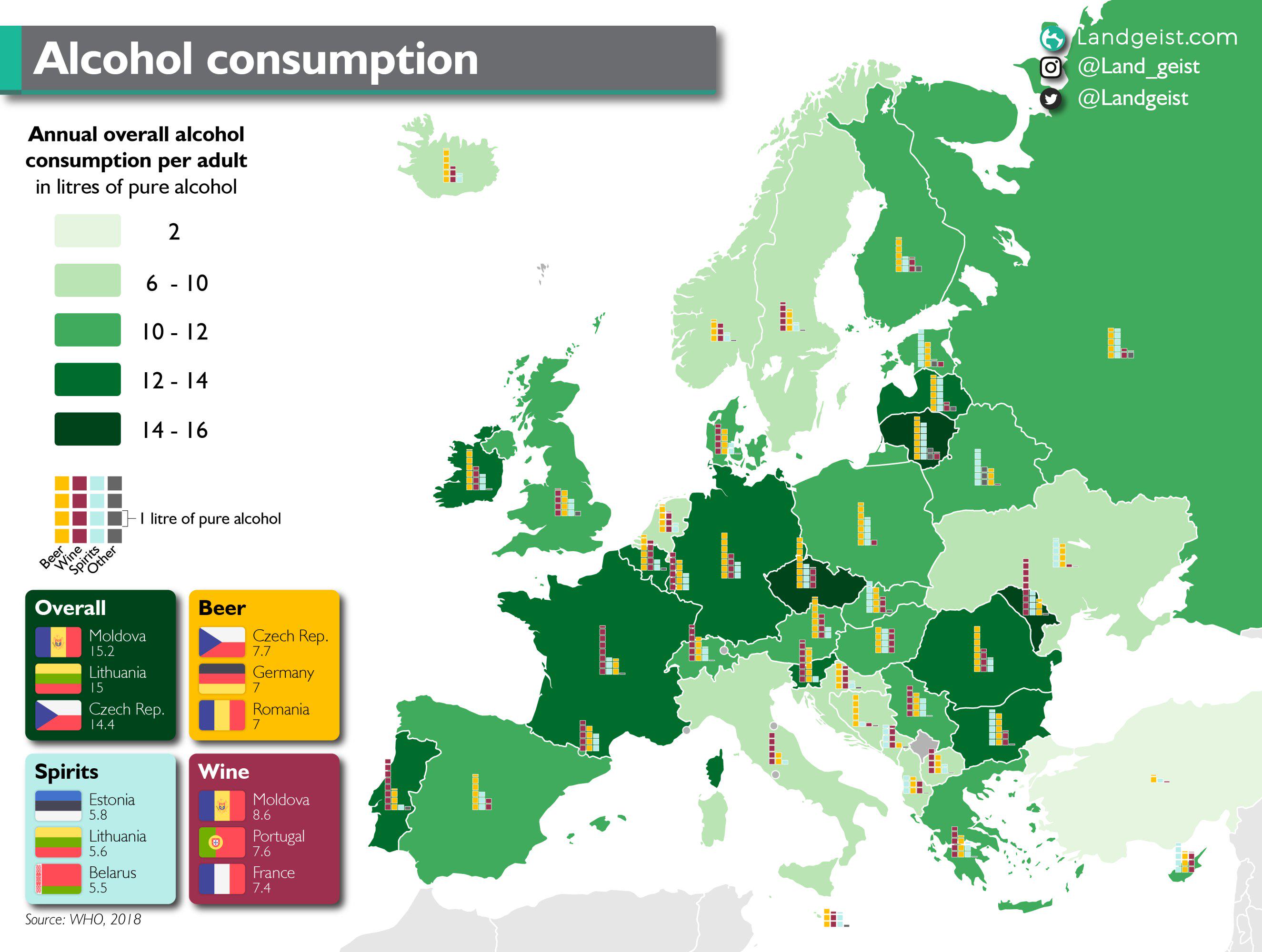European Alcohol Consumption Map 2024


Marcus Rodriguez
Historical Geography Expert
Marcus Rodriguez specializes in historical cartography and geographic data analysis. With a background in both history and geography, he brings unique...
Geographic Analysis
What This Map Shows\nThe European Alcohol Consumption Map of 2024 provides an insightful look into the drinking habits across various countries in Europe. Highlighting levels of consumption per capita, this visualization allows us to examine the cultural, social, and economic factors influencing alcohol use. Each country is color-coded to reflect its average annual alcohol consumption, making it easy to see where drinking is most prevalent and where it is comparatively low.
Deep Dive into Alcohol Consumption in Europe\nAlcohol consumption is more than just a statistic; it's intertwined with cultural practices, social norms, and even health policies. The average alcohol consumption per capita in Europe varies dramatically, often reflecting historical and societal influences. For instance, countries like the Czech Republic and Austria consistently rank among the highest in alcohol consumption per capita, with some individuals reportedly consuming around 14 to 15 liters of pure alcohol per year. This prevalence can be traced back to centuries of brewing traditions and social rituals surrounding drinking.
Interestingly, the cultural acceptance of alcohol in these regions plays a significant role in these statistics. In many Central and Eastern European countries, drinking beer or wine is a common social activity, often associated with celebration and community gatherings. On the other hand, nations like Italy and France have a long-standing tradition of wine consumption, which is not merely recreational but also part of the culinary experience.
However, the map reveals stark differences in consumption levels across Europe. For example, Scandinavian countries, such as Sweden and Finland, showcase lower alcohol consumption rates, often attributed to stricter regulations and social policies aimed at reducing alcohol-related harm. These nations have implemented effective measures such as high taxation on alcohol, limited availability, and public health campaigns that discourage excessive drinking.
Moreover, it's essential to consider the impact of these consumption trends on public health. The World Health Organization (WHO) highlights that excessive alcohol consumption is a leading risk factor for numerous health issues, including liver disease and mental health disorders. Countries with higher consumption rates often face significant public health challenges, prompting governments to initiate preventive measures.
Regional Analysis\nWhen we break down the map by region, we can see fascinating trends emerge. Western Europe typically showcases higher levels of alcohol consumption, with countries like Portugal and Spain having notable wine cultures. In contrast, Eastern European countries, while they have high consumption rates, are also grappling with the negative impacts of alcohol misuse. For instance, Russia has been long known for its high vodka consumption, which has led to serious public health concerns, including addiction and mortality related to alcohol.
Interestingly, Southern Europe presents a mixed bag; while Spain and Italy enjoy high wine consumption, Greece has lower levels, possibly due to a cultural emphasis on moderation. Northern countries, like Norway and Denmark, exhibit a different trend where alcohol is consumed socially but regulated heavily, leading to a lower per capita average.
Additionally, emerging trends show that younger generations in many European countries are beginning to drink less than their predecessors. This is particularly evident in urbanized areas where health consciousness is on the rise, leading to a significant shift in social behaviors surrounding alcohol.
Significance and Impact\nUnderstanding alcohol consumption trends is crucial for various reasons. It informs public health policies and helps governments strategize on how to address alcohol-related issues effectively. For instance, recognizing that higher consumption correlates with increased health risks allows policymakers to implement targeted education and prevention programs.
Moreover, with the rise of a health-conscious society, the future of alcohol consumption in Europe may see a transformative shift. As younger people embrace wellness trends, the demand for low-alcohol or alcohol-free alternatives is growing. This trend could reshape the market dynamics in the beverage industry and lead to a cultural shift towards moderation.
Ultimately, the European Alcohol Consumption Map of 2024 not only sheds light on current drinking habits but also serves as a crucial tool for understanding the broader implications of these behaviors on health, society, and the economy. It invites us to reflect on how we, as a society, approach alcohol consumption and its place in our daily lives.
Visualization Details
- Published
- August 9, 2025
- Views
- 244
Comments
Loading comments...